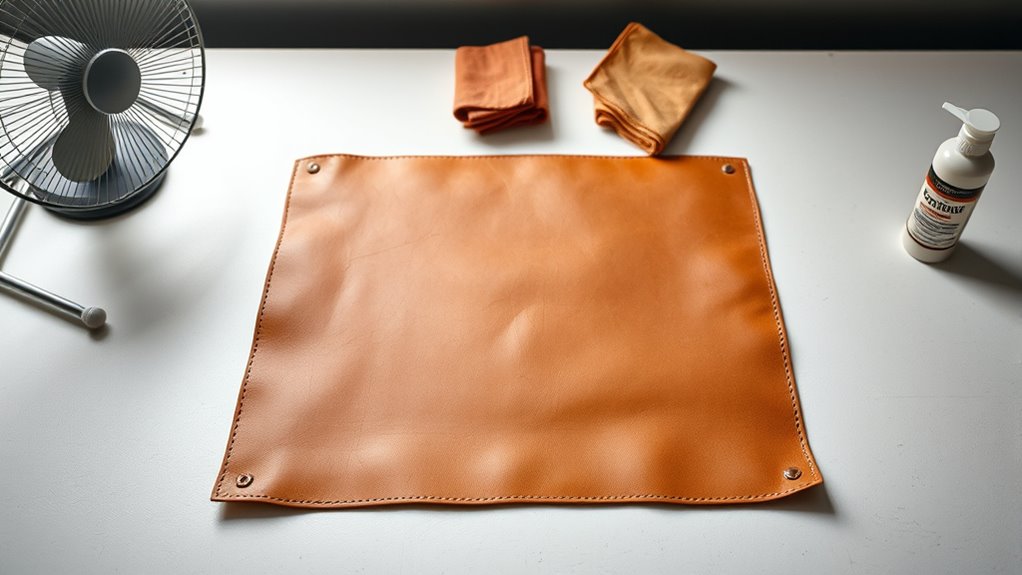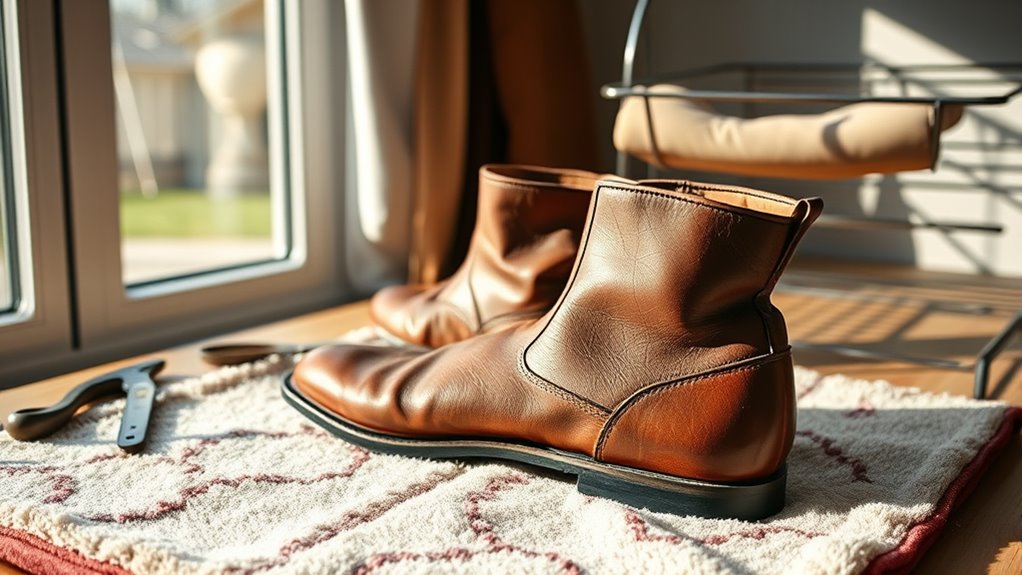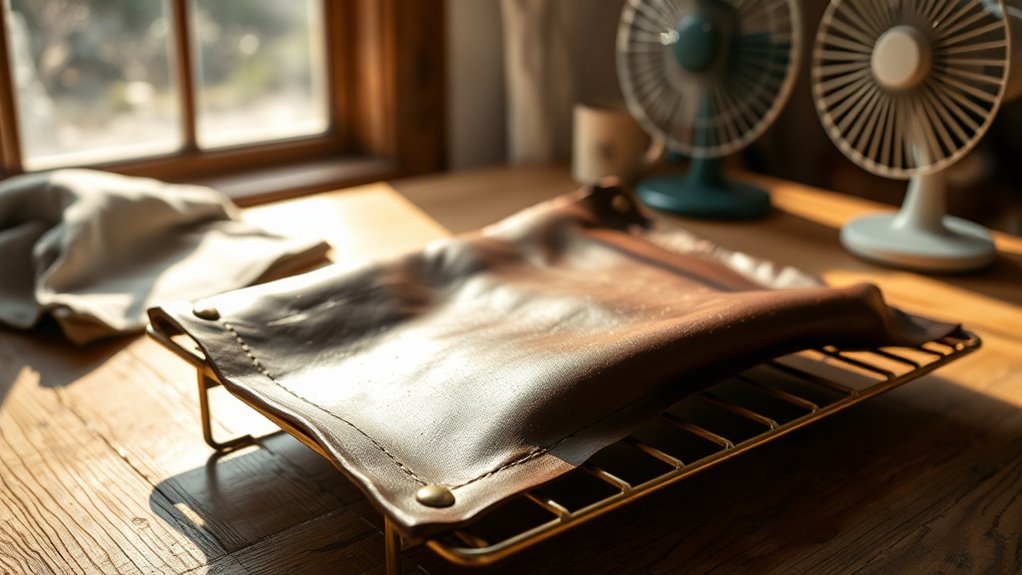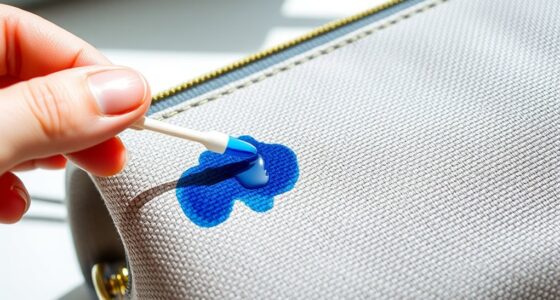To air-dry wet leather properly, gently remove excess water with a soft cloth and lay it flat on a supported surface in a cool, well-ventilated area away from direct sunlight. Avoid sealing or wrapping the leather to prevent moisture buildup and mold. Handle it carefully to prevent cracking or warping, and don’t rush the process. Following these steps helps preserve its flexibility and finish—if you continue, you’ll discover more essential tips for successful air-drying.
Key Takeaways
- Do gently wipe excess water with a soft cloth before air-drying.
- Don’t expose leather directly to sunlight or high heat during the drying process.
- Do lay leather flat on a supported, clean surface to ensure even drying.
- Don’t wrap or seal leather in containers to prevent moisture buildup and mold growth.
- Do handle leather with clean hands or gloves to maintain its quality and flexibility.
Proper Preparation Before Air-Drying

Before air-drying wet leather, you need to prepare it properly to prevent damage and guarantee a smooth drying process. Start by using hydration techniques, such as gently wiping off excess water with a soft cloth, to avoid uneven drying or cracking. Proper storage tips are essential; keep the leather in a cool, well-ventilated area away from direct sunlight, which can cause drying and fading. Avoid wrapping the leather tightly or placing it in sealed containers, as this traps moisture and may lead to mold. Instead, lay it flat on a clean surface, ensuring it’s supported evenly. These steps help maintain the leather’s flexibility and prevent warping, ensuring it dries evenly and retains its quality over time. Additionally, understanding the importance of proper handling can greatly influence the overall preservation of leather items during air-drying.
Essential Steps and Common Mistakes to Avoid

To guarantee your leather dries properly, follow essential steps carefully and steer clear of common mistakes. Proper moisture removal is vital; rushing the process can cause stiffness or warping. Avoid direct sunlight, which can dry leather unevenly and damage its finish. Remember to handle leather with clean hands or gloves to prevent dirt and oils from affecting leather cleaning. Additionally, understanding air-drying techniques can improve the overall outcome and preserve your leather’s quality.
Frequently Asked Questions
Can I Air-Dry Leather in Direct Sunlight?
You shouldn’t air-dry leather in direct sunlight because sunlight damage can cause the leather to crack and weaken. Plus, prolonged exposure to sunlight may lead to leather discoloration, ruining its appearance. Instead, find a cool, shaded area with good airflow to dry your leather gently. This helps preserve its color, texture, and overall quality, ensuring your leather item stays looking its best for longer.
How Long Does It Take for Leather to Fully Dry?
The drying time for leather varies depending on thickness and environmental factors. Typically, it takes 24 to 48 hours for leather to fully dry, but humidity control plays a vital role. If you keep the air around it dry and well-ventilated, drying speeds up. Avoid direct sunlight, as it can cause damage. Check your leather regularly to prevent over-drying and cracking.
Is It Safe to Use a Hairdryer on Wet Leather?
Using a hairdryer on wet leather isn’t safe because the heat can cause leather cracking and uneven moisture absorption. The rapid drying process can weaken the material and damage its surface. Instead, you should let the leather air dry slowly in a well-ventilated area. This helps maintain its flexibility and prevents cracking, ensuring your leather stays in good condition without risking damage from excessive heat.
Should I Apply Conditioner Immediately After Drying?
Did you know that applying leather conditioning within a week of drying can extend your leather’s lifespan by up to 30%? After air-drying your wet leather, it’s best to wait until it’s completely dry before applying conditioner. This guarantees proper absorption and preserves the leather’s quality. Using the right drying techniques prevents damage, so don’t rush—wait until it’s dry, then condition to keep your leather soft, supple, and durable.
What Are Signs of Over-Drying Leather?
You might notice signs of over-drying leather when it feels excessively stiff, brittle, or shows cracks, indicating moisture damage. Over-drying can lead to leather cracking and weakening its structure. If you see these signs, it’s a clear warning that you’ve removed too much moisture. To prevent this, always monitor the drying process and avoid prolonged exposure to heat or direct sunlight, which can accelerate over-drying and damage.
Conclusion
Remember, proper preparation guarantees your leather dries beautifully. For example, skipping cleaning before drying can lead to stains or damage. Always remove excess moisture gently and keep the leather away from direct heat. By following these dos and don’ts, you’ll preserve your leather’s look and longevity. Don’t rush the process—patience is key. With careful care, your leather goods will stay supple and beautiful for years to come.









